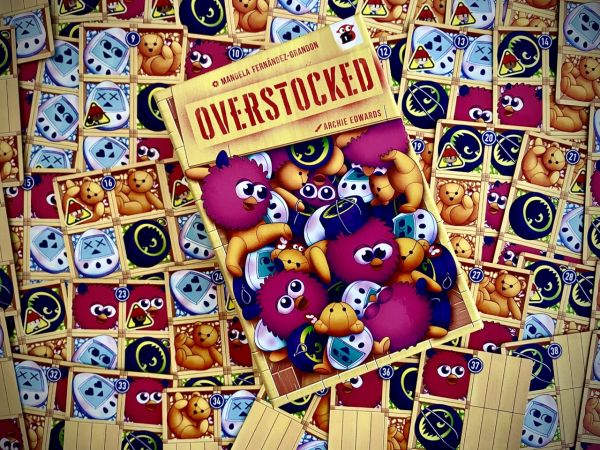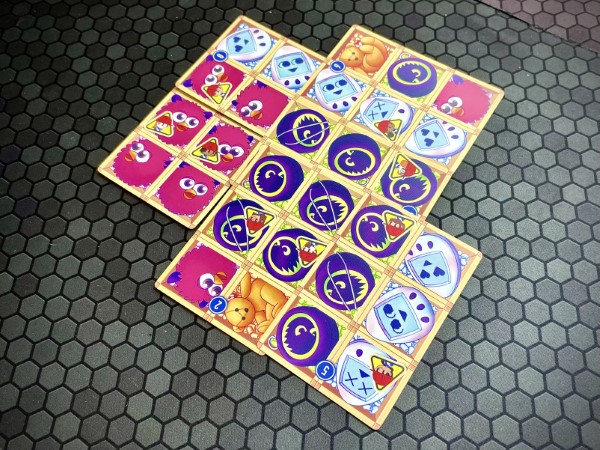Embrace the Toy Craze Unleashed in a Delightful Overstocked Review

Don't judge a board game by its cover; when it comes to Overstocked, behind the adorable and cute artwork lies a deeply strategic and thrilling game that will keep you on your toes till the end game! On a nostalgic trip to the nineties, you're in charge of a toy shop warehouse that you will fill up with Tamagotchis, Furbies, Yo-yos, and Teddies. You must stay up-to-date with the trendiest, in-demand toys and avoid investing in a craze that has already fizzled out. Be strategic with your marketing campaigns to influence the Popularity of the toys. However, the marketplace is unforgiving, and from one moment to another, the latest trend may quickly turn into a flop.
Running a toy shop is both an exhilarating and rewarding endeavor. With your creativity and business insight, overcome challenges and ensure your business's success. Stay sharp, embrace the ever-changing trends, and bring joy to the world through the magic of toys!
Overstocked is a quick, interactive, spatial card game designed for 1-6 players, ideally played with six participants. A match typically lasts around 20 minutes, making it an excellent choice for those looking for a fast-paced game. It is recommended for players aged 12 and older.

Master the Art of Toy Management in Overstocked: A Gameplay Overview
To start Overstocked, shuffle and deal six Crate cards to each player. Place one face-up Crate Card in the center as the Popularity area. Each player draws a Crate Card and places it face-up as their warehouse. Return the remaining Crate Cards to the box.
In Overstocked, players strategically position cards in their warehouse and the Popularity area to impact toy values. The game consists of six rounds where players simultaneously select a Crate Card and reveal them based on card numbers, determining turn order. Starting with the lowest numbered card, players take turns placing their chosen Crate Card in the Popularity or their warehouse, covering one or two toy spaces. Cards can be rotated to align with the spaces while keeping workers visible. The round ends when all players have placed their Crate Cards.
After six rounds and once all players have played their final Crate Card, the game concludes. Scoring is based on toy types, as players tally the number of crates in the largest connected area for each toy in the Popularity area and their warehouse. The toy with the largest connected area in the Popularity area receives a negative score, subtracted from the total. In the case of a tie for the largest connected area, the toy with the most visible crates scores negatively. Each player decides which tied toy scores negatively for them. Using the provided Scorepad, players calculate the points for all four toy types, and the player with the highest total score claims victory. If there is a tie, the tied players share the triumph.
The game includes three mini-expansions, a solo mode, and an advanced variant.

The modular table featured in these photos is the AdapTableTop.
Crafted Mechanics and Surprising Depth: Unveiling Overstocked's Strategic Brilliance
Overstocked is an abstract strategy card game that incorporates several game mechanisms, including tableau, tile placement, pattern building, pattern recognition, layering, commodity speculation, and hand management. There are no drafting mechanics; you will play with the six cards you started the game with. These many mechanics are crafted and intertwined to achieve an extraordinary result. From a gameplay perspective, this interwoven blend flows seamlessly. Being an enthusiast of abstract strategy tile placement games, I was surprised and mesmerized after my first match. I had completely different expectations for the game, wrongly assuming it was purely casual for young kids. Instead, this is a "LIGHT game with DEEP strategy."
Deductive reasoning is required to speculate how the Popularity pool might evolve. The Popularity pool is a deal breaker. The pattern built at the end of the game determines how players will score. If you have built an extensive connected area of Tamagotchis, for example, leading the game, but at the last turn, the Tamagotchis have the biggest area in the Popularity pool and go bust, you will lose many points and probably lose with a massive amount of negative points. That's why social deduction really matters in this game. You must figure out the plans of your adversaries to foresee how they might change the Popularity pool so that you can plan accordingly and minimize your risks. It can be really frustrating when it seems that you are the clear winner of the game till the last card is drawn, the odds turn against you, and from victorious, you end up being the biggest loser. This mechanism is called commodity speculation, when "commodities" (toys) change value throughout the game. It's the core mechanism in the game and the most significant one to get to grips with so that you can strategize and adapt as the game evolves. Commodity speculation and deductive reasoning are really exceptionally implemented in the gameplay. They really shine and make this game thrilling, engaging, and addictive.
Tableau, tile placement, pattern building, pattern recognition, and layering are all popular mechanisms widely employed in tandem. They lend Overstocked welcome familiarity and help make the rules intuitive.
In fact, the rules are simple and straightforward, "easy to learn but difficult to master." Any player with minimal experience in tile placement games will feel at home here. It takes a few minutes to explain the rules and start the game. However, the game is extremely tricky because what lies behind the straightforward rules is a deeply strategic game.
The game has minimal complexity, but it does have depth, and it is quick to set up and teach. It also has minimal downtime because players choose their card to play simultaneously. This is followed by a phase of resolution when everyone is vigilant and attentive because game odds are constantly changing. Add to it the deductive nature of the gameplay, resulting in a game where player interaction and social involvement shine.
While the game has significant depth, it is very accessible and approachable. It strives to appeal to both newbies and expert players alike. It is quick and fast-paced, making it an ideal filler game. And it is also an excellent and engaging gateway game to introduce new players to the hobby. This gives them exposure to a plethora of widespread gameplay mechanisms.
The game is intrinsically uncertain because it relies on drawing random cards. However, it is designed to be balanced despite its inherent randomness. There is nothing like a "bad hand" in this game. Players must adapt continuously to the challenges presented and have full agency to influence the Popularity pool or decide to expand their warehouse. Social and performance contingency stand out. Victory relies on strategy above all. Yet, there is an ever-present feeling of unpredictability, and even the best players may get beaten by surprise at the last moment. Thus, all of this leads to a highly thrilling and captivating experience. You will want to come back for more!
Fictional and material involvement are closely interconnected, and they are superb. The game's adorable artwork excels at delivering an immersive and thematic experience, very nostalgic. This is complemented by gameplay that is cohesive and coherent with the theme. Unlike most abstract strategy games, the toy-shop-warehouse theme is effectively portrayed, and it is not merely a backdrop to a purely abstract game. Gameplay and the theme are tightly and successfully linked.
Overstocked gameplay is so quick, fast-paced, engaging, and addictive that it boasts significant replayability. In addition, the game comes with three mini-expansions, a solo mode, and an advanced variant to provide even further replayability to the game. As a result, I can easily see Overstocked enjoying plenty of table time!

Verdict
With Overstocked, one can definitely say that the best games come in small boxes! Overstocked surprises with its adorable artwork and deep strategic gameplay, where players manage a nostalgic toy shop warehouse, stay ahead of trends and manipulate toy values. With simultaneous card selection, strategic placement in the Popularity area and warehouse, and scoring based on connected areas, the game keeps players engaged throughout its quick-paced six rounds. Deductive reasoning, intuitive mechanics, and a balanced mix of strategy and unpredictability make Overstocked a thrilling and addictive experience. Its immersive theme, replayability options, and cohesive gameplay ensure this delightful game will have a cherished spot on any tabletop.
Pros:
- Overstocked offers a deep and strategic gaming experience, requiring players to make calculated decisions and adapt to toys' ever-changing trends and values.
- Overstocked successfully combines its appealing theme with cohesive gameplay, creating an immersive experience where players genuinely feel like they are running their own toy shop warehouse.
- The game encourages social interaction and engagement as players must deduce their opponents' plans and strategize accordingly. This adds an element of social deduction and makes each game session dynamic and exciting.
Cons:
- Despite efforts to balance the randomness, the game still heavily relies on drawing cards, which can introduce an element of luck that some players may find frustrating or feel diminishes their control over the outcome.
- As the game progresses and strategic decisions become more critical, some players may experience analysis paralysis, feeling overwhelmed by the multitude of choices and the potential consequences they entail.
- Due to the scoring mechanics, there can be significant swings in scoring outcomes, leading to situations where a player's chances of victory dramatically change in the final rounds. This can create a sense of unpredictability that may not appeal to players who prefer a more consistent and predictable gameplay experience.
Disclosure: we received a complimentary review copy of this game.
Note: This article is provided by Roll & Mind.






